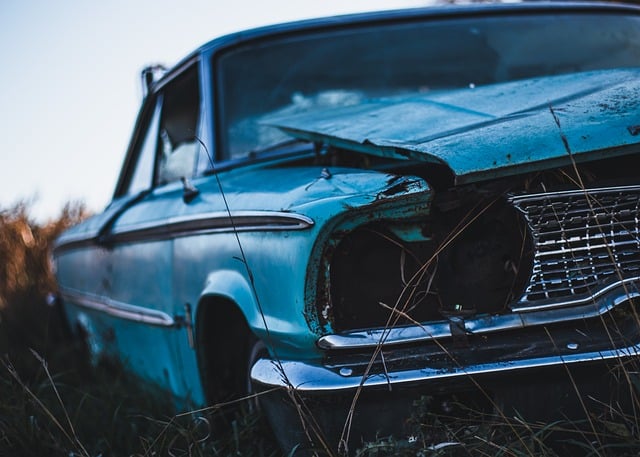When considering the purchase of a vehicle from a salvage car auction, it's important to understand the implications of a salvage title, which indicates the vehicle was previously declared a total loss by an insurance company due to significant damage from accidents or natural disasters like floods. Such vehicles can be repaired and rebranded with a rebuilt title after meeting state-specific legal and safety standards set by the Department of Motor Vehicles or equivalent authorities. Prospective buyers must conduct a thorough assessment of the vehicle's condition, including its repair history and type of damage, especially if it was flood-damaged. The rebuild process is subject to strict regulations, and upon successful completion, the vehicle is issued a rebuilt title. Buyers should familiarize themselves with their state's laws concerning rebuilt titles to avoid legal issues. A salvage car auction can offer these vehicles at lower prices than new or undamaged used cars, but success hinges on careful inspection, adherence to legal procedures, and the willingness to invest in potential repairs. By doing so, investors can turn a repairable vehicle with a salvage title into a profitable asset, provided all repairs are up to standard and the vehicle passes state inspections. Overall, purchasing a damaged car from a salvage car auction for resale or personal use can be a cost-effective option if approached with due diligence and an understanding of the salvage and rebuilt title processes.
Exploring the world of salvage vehicles can be a financially savvy move for car enthusiasts and budget-conscious buyers. These vehicles, often mischaracterized as lost causes, are former totals or insurance write-offs available at salvage car auctions. They come with attractive price tags that promise significant savings. However, the path to transforming these wrecked cars into dependable transportation isn’t without its challenges. This article demystifies the process of acquiring a vehicle with a salvage title, from understanding the implications of such a title to navigating the legalities and conducting thorough inspections. With the right knowledge and due diligence, buyers can successfully rebuild and restore these vehicles, unlocking their potential for optimal return on investment.
- Understanding Salvage Titles and Their Implications for Buyers
- Evaluating the Condition of Repairable Vehicles at Salvage Car Auctions
- The Legalities: Title Branding, Regulations, and Rebuilt Titles Explained
- Assessing Damaged Cars: What to Look for in a Pre-Purchase Inspection
- Maximizing Value: The Process of Rebuilding a Wrecked Vehicle into a Roadworthy Machine
Understanding Salvage Titles and Their Implications for Buyers
When contemplating the acquisition of a salvage vehicle from a salvage car auction, understanding the implications of a salvage title is paramount. A salvage title indicates that a vehicle has been declared a total loss by an insurance company due to extensive damage, often resulting from accidents or natural disasters like floods. This designation can also apply to wrecked vehicles or damaged cars that have been repaired and are deemed roadworthy again, transitioning to rebuilt title status. Owners of such vehicles must inform the relevant authorities and ensure the vehicle undergoes a thorough inspection before it can be assigned a rebuilt title. It’s crucial for buyers to research and comply with state-specific laws regarding salvage titles and rebuilt titles, as these can vary significantly. A salvage title may affect resale value, insurance coverage, and financing options. However, for those prepared to invest time and resources into the repair process, a salvage vehicle can be an economical alternative to purchasing a new or used car. The journey from a salvage title to a rebuilt title requires meticulous documentation and adherence to legal requirements, but successful completion allows these vehicles to regain their value and offer a substantial return on investment for savvy buyers.
Evaluating the Condition of Repairable Vehicles at Salvage Car Auctions
When navigating salvage car auctions in search of a bargain, it’s crucial to thoroughly evaluate the condition of each repairable vehicle. A vehicle with a salvage title, often resulting from an accident or natural disaster, indicates that the car has been declared a total loss by the insurance company. This designation is critical for potential buyers as it signals the need for a meticulous inspection. Prospective owners must assess the extent of damage and determine whether the vehicle can be restored to safe, operational condition. This involves examining the repair history, the type of damage incurred, and the quality of any previous repairs, especially if the car was a flood-damaged vehicle, which may have hidden issues that could compromise safety and performance.
Purchasing a wrecked vehicle with a salvage title comes with the understanding that the vehicle will likely require significant investment to bring it back to the road. The rebuild process for such vehicles is regulated and must be completed according to state laws, resulting in a rebuilt title upon successful completion. This rebuilt title is a legal document that signifies the car has been repaired to the satisfaction of the state’s Department of Motor Vehicles (DMV) or equivalent authority. It’s imperative to understand these regulations as they can vary by state, and failure to comply with them could result in legal complications. By carefully evaluating a salvage vehicle at a salvage car auction and understanding the implications of a salvage title or rebuilt title, buyers can make informed decisions and potentially acquire a totaled car that holds great value once restored.
The Legalities: Title Branding, Regulations, and Rebuilt Titles Explained
When considering the purchase of a salvage title vehicle from a salvage car auction, it’s crucial to understand the legalities surrounding title branding and the process of rebranding a totaled or wrecked vehicle as a rebuilt title vehicle. A salvage title is assigned to a damaged car that has been deemed a total loss by an insurance company due to accidents, natural disasters like floods, or other significant damages. This title brand indicates that the vehicle’s previous condition was so severe that the cost of repairs exceeded the value of the car at its pre-damage state. Owners of such vehicles must navigate the specific regulations in their jurisdiction, as each state has its own set of laws and procedures governing the rebranding process after necessary repairs are completed.
Once a vehicle with a salvage title undergoes successful repair and restoration, it can be re-evaluated by the state’s department of motor vehicles (DMV) to determine if it meets all safety and legal requirements. If it passes this evaluation, the vehicle can then be issued a rebuilt title. A rebuilt title signifies that the car was once a salvage vehicle but has since been brought up to roadworthy standards. It’s important for buyers of rebuilt title vehicles to ensure that all repairs have been performed to the state’s specifications and that all necessary paperwork is in order. This includes having a clear understanding of the vehicle’s history, as a salvage or rebuilt title can affect its resale value and insurance rates. Buyers should conduct a thorough salvage car inspection and review the vehicle’s history report to ascertain the extent of previous damage and repair work. By adhering to these guidelines, buyers can successfully navigate the complexities of salvage title vehicles and find a damaged car that offers a great return on investment at a salvage car auction.
Assessing Damaged Cars: What to Look for in a Pre-Purchase Inspection
When considering the purchase of a salvage titled vehicle from a salvage car auction, conducting a thorough pre-purchase inspection is paramount. A salvage title, indicative of a vehicle that has been damaged extensively in an accident or deemed a total loss by an insurance company, can be a red flag. Prospective buyers must examine the vehicle’s Vehicle Identification Number (VIN) to ensure it matches the title and reflects any previous damage history. It’s crucial to assess the extent of the damages, as vehicles labeled as repairable may have hidden issues that could compromise safety and performance. Look for signs of flood damage, frame straightening, airbag deployment, or evidence of improper repairs that might hinder the vehicle’s future reliability.
Inspecting a salvage car requires a keen eye; check for mismatched parts, corrosion in critical components, and ensure all documentation is in order. The rebuild process for a vehicle with a salvage title is complex and must be completed according to state regulations to obtain a rebuilt title. This process includes not only the mechanical repair but also the replacement of any part that could not be repaired, such as body panels, which should be marked as ‘rebuilt’ or ‘salvaged.’ Understanding the difference between salvage titles and rebuilt titles is essential, as each state has its own set of rules and guidelines for these vehicles. Buyers must verify that all repairs have been made to code and that the vehicle passes a state inspection before they can be confident in their purchase. A properly rebuilt repairable vehicle can indeed offer great value and return on investment, but it’s the buyer’s responsibility to ensure the vehicle has been restored responsibly.
Maximizing Value: The Process of Rebuilding a Wrecked Vehicle into a Roadworthy Machine
When venturing into the realm of salvage vehicle investments, one of the most lucrative avenues to maximize value is through the rebuilding process of a wrecked vehicle. A salvage title car, often deemed a totaled car due to its accident history or flood damage, presents an opportunity for savvy buyers to transform it into a roadworthy machine. The first step in this journey is acquiring the vehicle from a salvage car auction where these damaged cars are sold at significantly lower prices than their market counterparts. It’s crucial to thoroughly inspect the vehicle and assess the extent of damage before purchasing, as this will dictate the scope of repairs required.
Once acquired, the rebuilding process begins with a detailed appraisal to determine what parts can be salvaged and which components need replacement. The salvage title must be addressed; once the necessary repairs are completed and the vehicle passes a state inspection, it can transition from a salvage title to a rebuilt title. This transformation is not just a legal change but also a testament to the diligence and expertise applied in the rebuild process. Each step of the repair, from structural integrity checks to mechanical overhauls, should be documented meticulously to ensure compliance with state laws governing rebuilt titles. Upon successful completion of these steps, the vehicle not only regains its roadworthiness but also retains or even appreciates in value, making it a sound investment for individuals looking to save on transportation costs while also potentially increasing their asset’s market value.
When exploring the market for a cost-effective vehicle, considering a salvage title option can be a financially savvy decision. By understanding the implications of a salvage title through a rebuilt title, buyers can navigate the legalities and inspect the condition of their potential purchase effectively. With diligent research and a meticulous approach to assessing damaged cars, such as those found at salvage car auctions, one can identify repairable vehicles with the potential for restoration into roadworthy machines. The key to success lies in comprehending the distinctions between totaled cars, wrecked vehicles, and their journey towards becoming a reliable means of transportation. For those ready to invest time and resources into a salvage vehicle, the rewards can be substantial, offering both financial savings and personal satisfaction from bringing a vehicle back to life.



